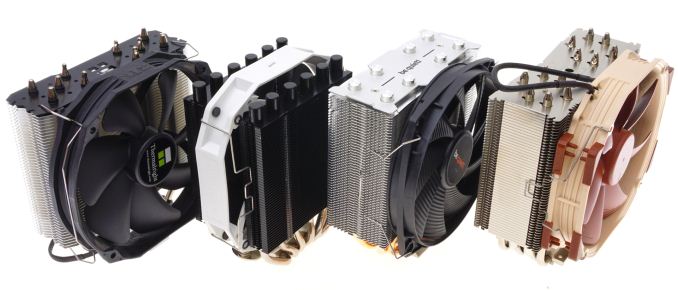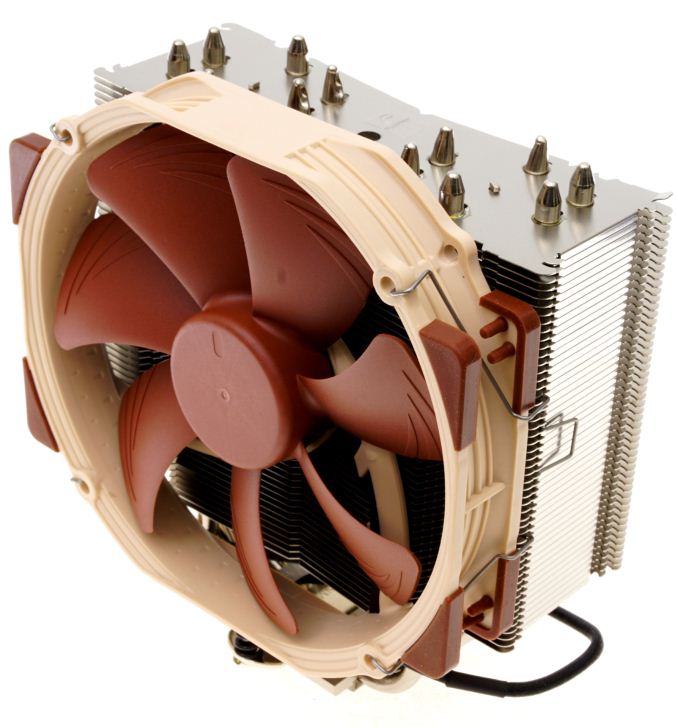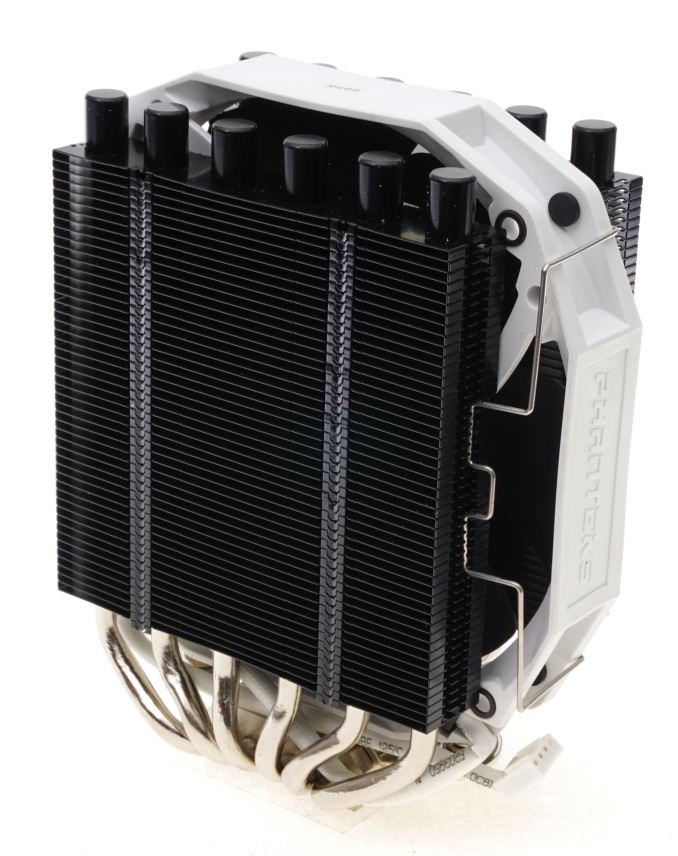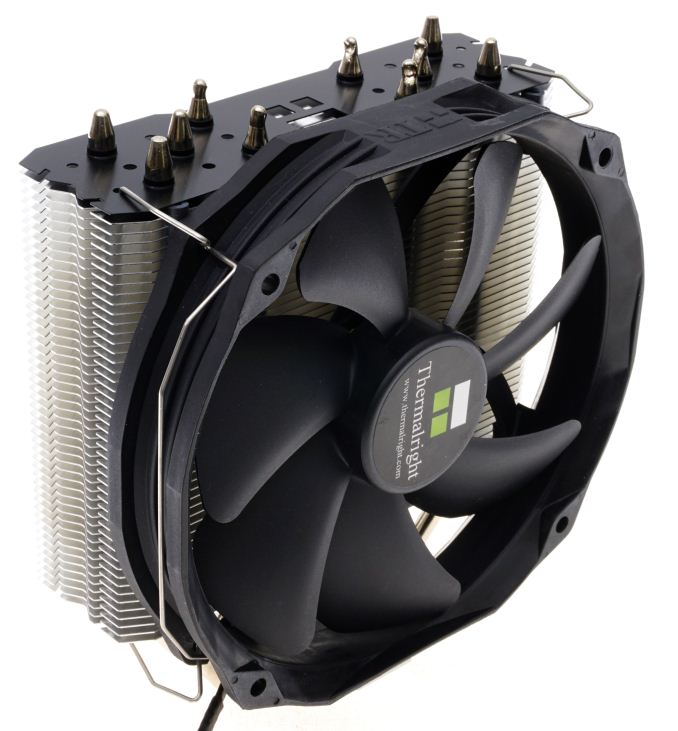The 140mm Slim Tower CPU Cooler Roundup: Thin & Light Done Just Right
by E. Fylladitakis on May 24, 2017 8:00 AM EST- Posted in
- Cases/Cooling/PSUs
- be quiet!
- Noctua
- Phanteks
- Cooler
- Thermalright
Final Words
Although 140 mm tower coolers are slightly restrictive in their compatibility – essentially requiring the user to own a case that is wide enough to fit them – their close pricing and superior characteristics relative to 120 mm tower coolers makes them the sensible choice for every enthusiast that owns a compatible case. The four coolers in this review are but a small sample of the “slim” 140 mm coolers available today, comprising of the higher quality and most popular models.
Out of these four coolers, Noctua’s NH-U14S stands out by pretty much every metric. It is a little larger than the other three coolers and, even though the difference is small, extra caution is required when checking whether it can fit inside a case. At $65 it's also more expensive than the other three models by around 30% ($15), which makes it substantially more expensive. Nevertheless, the thermal performance of the NH-U14S is significantly superior as well, especially when the cooler needs to handle a high thermal load. This higher thermal performance coupled with Noctua's excellent reputation for their after-sales support gives the NH-U14S an edge over its competition, regardless of its higher retail price.
The Phanteks PH-TC14S was the oddity of this review. Instead of doing a single tower cooler, the designer’s solution for a “slim” design was a greatly cropped version of the monstrous PH-TC14PE. The narrow and thin towers hardly cover the effective airflow area of the 140 mm fan that is sandwiched between them, and the positions of the heatpipes do not appear to be optimal. Still, the PH-TC14S performs very well overall, better than what we originally anticipated when we physically examined the cooler. The lack of mass places it at a disadvantage when it needs to deal with very high thermal loads, but it will be more than sufficient for the average gamer and amateur overclocker. It also is the only cooler that is currently available with black fins, drawing the attention of those who prioritize aesthetics over small performance differences.
Thermalright’s True Spirit 140 Direct was the surprise performance of this roundup review. Nothing foretold that the otherwise simple-looking cooler could give the competition such a push. The direct contact design of the True Spirit 140 Direct grants the cooler excellent energy absorption efficiency, giving the cooler a significant performance advantage that is especially apparent when the thermal load is low. This design makes the True Spirit 140 Direct particularly efficient when dealing with low thermal loads, i.e. modern efficient CPUs that will not be significantly overclocked. It is not as efficient when it has to deal with a very high thermal load, as it cannot dissipate the amassing thermal energy as quickly as Noctua’s behemoth can, but even then the performance figures remain very good. Its sound pressure levels are relatively low as well, making it a sensible choice for users who want a relatively simple, efficient, low noise product.
Finally, the Be Quiet! Shadow Rock Slim is not the best overall performer of this roundup review, but we feel that it is right where the company wanted it to be. Its thermal performance is competitive, rivaling that of every other cooler in this roundup, and even coming close to its much larger and considerably more expensive counterpart, the Dark Rock Pro 3. At the same time, the sound pressure level readings of the Shadow Rock Slim are the lowest of this review, even if only by a little, making it the quietest of the coolers. Overall, the Shadow Rock Slim is a balanced, high quality cooler that should appeal to the widest user’s base in comparison to the other coolers of this review. If the company were to bring the price of the cooler down even just a bit, then the competition would have a lot to worry about.















74 Comments
View All Comments
Samus - Wednesday, May 24, 2017 - link
I think the thermalright cooler is pretty hard to ignore unless you are running a high-wattage CPU. Mild overclocks of a typical 80w CPU will make the thermalright the ideal solution at ~100w load, and also the quietest.Communism - Wednesday, May 24, 2017 - link
The problem with E. Fylladitakis 's style of testing is that they miss major factors in how the things tested actually function in relation to what they are made for.The reason why Noctua always does "better" in these synthetic tests is that they generally have a 100% flat contact surface.
The problem with 100% flat contact surfaces is that CPU IHS aren't anywhere close to 100% flat surfaces.
Most CPU IHS are concave, which is why Thermalright HSF always have convex contact surfaces.
Clamping pressure is also highly important, especially for Intel's non-soldered IHS CPUs.
Higher Clamping pressure both reduces the distance between the silicon and the IHS as well as forms a better mating between the IHS and the convex Thermalright contact surfaces.
These, and many other major factors that crop up in the real world make the 100% artificial testing like E. Fylladitakis conducts in actually have an extremely large margin of error, making them far less useful than the testing "scienciness" would lead you to believe.
fanofanand - Thursday, May 25, 2017 - link
If what you are suggesting is true, we should see Thermalright outperforming Noctua in every other publication's testing, correct? Most review sites (I believe all other sites actually) test CPU cooler performance on an actual CPU running tests, and more often than not inside of an actual computer case. Yet those same tests bring very similar results to what Anandtech has shown, which would appear to invalidate your entire postulation. How do you explain the lack of disparity between these other journalists' "real world" cases, and what Anandtech has done?Communism - Thursday, May 25, 2017 - link
Keep up your rhetorical questions.I don't know why I bother posting on this shill infested site anyways, waste of my time.
I'm not going to spoon-feed you for 20 posts like the forums.
I've spoonfed you for literally 100 posts before on the forums and your shill self has never acknowledged anything, making this a pointless conversation by any metric.
Have fun shilling with the other shills, adequate journalism in technology died quite a long time ago, and it shows.
Zetbo - Friday, May 26, 2017 - link
What a loser you are. When the data does not backup your point of view...you call everyone a shill! Thats the way to go! :DCommunism - Friday, May 26, 2017 - link
Took you a whole day to make another account?You really should get your pay docked.
Keep going and you're getting doxed.
fanofanand - Friday, May 26, 2017 - link
Doxx me big boy :)fanofanand - Friday, May 26, 2017 - link
Uh, I'm not on the forums, have you been taking mushrooms? I did read that they are the "least dangerous" psychadelics, but you seem to have overindulged. Apparently my point was irrefutable as you chose not to refute anything I wrote.BrokenCrayons - Friday, May 26, 2017 - link
The testing methods used in these HSF reviews are perfectly adequate because they remove a number of uncontrollable variables that would result from testing with PC hardware. The simulator equipment can produce repetable results with little to no variance between tests within AT's limited budget. I much prefer artifical tests as the basis for relative comparisons since the tests performed by other review sites won't accurately emulate my specific computing environment anyway and are therefore only useful as similarly relative comparisons. The science of these results appear trustworthy.WinterCharm - Thursday, May 25, 2017 - link
Funny how Thermalright performed better than Noctua at low and high fan speeds, then!